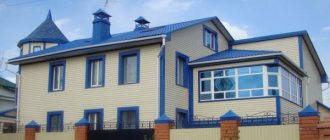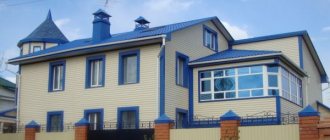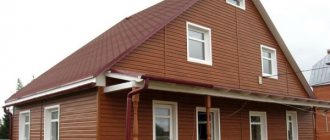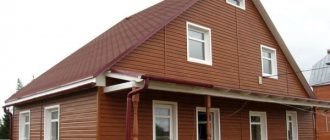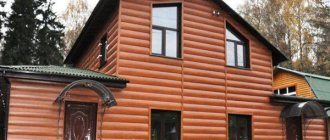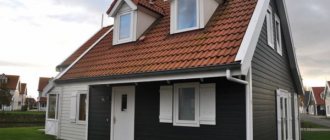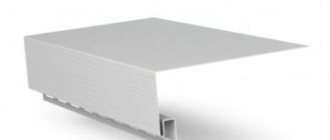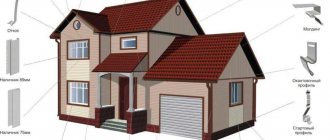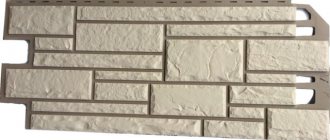Siding is one of the most common facing materials. With its help, you can carry out both internal and external finishing of various surfaces.
Siding has a huge range of protective properties against all kinds of negative environmental influences.
It is also an excellent decorative material, presented on the building materials market in a wide variety of colors and textures.
The type of siding most often used for finishing facades is shipboard, which will be discussed in our article.
Areas of use
Siding has been used for many years to protect and insulate load-bearing walls of buildings. The most popular type of metal siding is “ship plank”. This type of finishing looks great both on one-story private houses and on tall buildings consisting of several floors.
Appearance is not the only advantage of this finishing material. Another equally important reason why the choice is made in favor of this particular type of siding is its low price. In addition, the sheathing process itself is inexpensive.
Advantages and disadvantages of the material
Plank colors available according to the RAL table.
Advantages of shiplap siding:
- A diverse range of decorative coating colors. It contains the entire range of the RAL standard.
- Fire safety due to inability to burn.
- The material is resistant to harmful microorganisms and rodents.
- Reliability, resistance to mechanical loads and a high level of strength.
The siding can withstand Russian frosts well.
- Resistant to temperature changes. Thus, metal strips can withstand from -60 C° to +120 C° without destruction or deformation.
- Chemical inertness. Immunity to the influence of chemicals, alkalis, salts.
- Environmental Safety.
- Long service life. Manufacturers provide a 20-40 year warranty on vinyl and metal siding.
- UV resistance.
You can also install the covering yourself.
- Easy and fast installation.
- Easy to care for. The coating can be washed and cleaned using household products.
- Low coefficient of linear expansion.
Disadvantages of coverage:
- Relatively expensive. This only applies to metal siding.
- Vinyl coating becomes brittle in severe frost.
- Steel planks weigh a lot, so they increase the load on the base.
Main characteristics
The advantages of siding include its ability to self-clean from dust and dirt that appears on the surface over time. All it takes is a little rain and all the dirt will be removed as if by hand. If there is no time to wait for rain and you urgently need to get rid of dirt and dust, then you can use ordinary water and a hose.
Another advantage of metal siding is its long service life. For the manufacture of this finishing material, only high-quality cold-rolled steel is used. “Shipboard” does not change its shape under the influence of temperature. It retains its original appearance even after severe frosts and great heat. In addition, this material is fireproof: it is not flammable.
The profile of metal siding resembles plank siding. Each panel has two wide waves that are located on top of each other. This results in a surface that resembles wood siding with overlapping planks. The special pattern on the surface also creates the impression that it is not a metal structure at all, but a wooden one. True, not all types of siding have such a pattern: the cheapest models, as a rule, have a monotonous surface.
The shape of the panels is given for a reason. The fact is that this design has good resistance to mechanical influences, and also perfectly resists wind and is able to remove excess moisture.
Like other metal models, the “ship plank” is produced by stamping. The traditional panel has a complex structure and consists of seven layers. The base layer is made of steel and is usually about 0.5 mm thick.
The material must be coated with zinc on both sides. This protects it from moisture. Another required layer is an oxide film. This substance also performs a protective function, preventing rust from forming.
In the production of metal siding, a special primer, polymers, varnish and decorative coating are used.
Shiplap panels can come in different sizes. But usually the height of one element is 14 mm, the width is 260 mm, and the length can reach up to 6 m. Some manufacturers manufacture the material to order, and therefore can create panels of almost any size.
Manufacturers
Most popular brands:
- Grand Line. Domestic company producing galvanized panels. The products have high performance characteristics and are very popular. The color range is represented by several dozen shades.
- "Metal Profile". A domestic manufacturer that produces various types of siding with excellent properties. There is a separate line of panels with imitation wood structure.
- Docke. A well-established foreign manufacturer that produces siding of excellent quality. The factory line for the domestic market is located in Russia, but all work is carried out using German technology. The color range of the panels is quite varied (see photo).
"Docke" is one of the most popular siding manufacturers in the CIS
Every serious brand provides its products with a description of the characteristics and installation technology.
Varieties of "ship planks"
Depending on the type of polymer coating, there are five varieties:
- Metal siding with a glossy polyester coating. Usually has a thickness of 25 microns. It is possible to cover the walls of a building with such material in almost any climate zone. Such panels are almost not exposed to ultraviolet rays of the sun. They also have good strength and elasticity.
- Metal siding with matte polyester coating. Thickness - about 35 microns. Due to the increased thickness of the protective layer, such panels have increased resistance to negative influences. They are even less susceptible to the influence of sunlight than the previous type.
- Metal siding with PVC coating. Thickness - about 200 microns. This material can last for many years, as it is well protected from various types of influences. The surface of such siding usually imitates real wood, and therefore looks very attractive.
- Metal siding coated with polyurethane resins. This material has excellent technical characteristics. It tolerates exposure to both high and low temperatures well.
- Metal siding coated with PVDF and acrylic. Its main advantage is its long service life. This board can be used for cladding the external surfaces of walls of buildings located in harsh climatic conditions.
What are the panels
Profile and dimensions of the plank.
When you look at the bar from the end, you can see a characteristic profile with a double fracture. It makes this siding look like wood planks for ship plating. Hence its name. The panels are connected to each other with a snap lock, and fixed to the wall with an edge with holes for fastenings.
Previously, shipboards were used by North Americans for protective finishing of their homes. When siding panels were developed, their wood predecessor fell out of use because it was more expensive and less durable.
Two types of planks according to material of manufacture
There are two types of ship siding, based on the material used:
| Photo | Description |
| Type 1: vinyl planks. They are made from polyvinyl chloride modified with additives. Advantages:
Disadvantages of PVC:
| |
| Type 2: metal panels Made from cold-rolled galvanized steel. The polymer front layer protects the planks from environmental influences. Advantages:
The downside is the large mass. |
Siding characteristics
Dimensions of panels imitating ship planks:
- double profile height - 1.4 cm;
- the total width of the strip is usually 26 cm;
- useful siding width - 22.6 cm;
- panel length - up to 600 cm.
The decorative front layer of metal material can serve as:
- polymer coating made of pural, plastisol or polyester, in this case the range of material is limited to eight colors;
- powder paint, then the palette of siding colors is not limited, but its cost increases by 15%.
All layers of metal "ship plank".
Thanks to its structure, metal siding is maximally protected from atmospheric and chemical influences.
Metal siding consists of the following layers:
- steel base;
- a thin film of zinc that prevents iron oxidation;
- anti-corrosion coating;
- primer, which improves adhesion between the main and decorative layers;
- a paint or film top coating that additionally plays a protective role.
Features of choice
In construction stores you can find “ship planks” from different manufacturers. There is almost no difference between them.
There are only two main differences:
- The thickness of the polymer layer, which plays an important role in protecting the boards from negative influences.
- Substances included in the composition. Different manufacturers may add different materials to their products.
When choosing metal siding, you need to pay attention not only to its properties, but also to its aesthetic qualities. The first step is to study the technical specifications. Be sure to clarify what substance is used as a protective coating.
You also need to find out whether the material will require maintenance during operation. If the answer to this question is positive, then it is advisable to refuse to purchase this type of material, since maintaining the outer cladding of a building is quite problematic at any time of the year, especially in winter. It is better to look for some other variety that will no longer require careful care. Fortunately, this material is quite popular and widespread, and finding samples with a surface more resistant to negative influences is not so difficult.
As for the color of metal siding, it is better to give preference to soft and calm tones, since brighter shades will soon lose their attractive appearance anyway, becoming covered with a layer of dust. It will look especially unsightly in clean areas.
When choosing a “ship plank”, as when choosing any other product, you inevitably have to pay attention to the cost. There is no need to rush to purchase large quantities of material if it is sold at a low price. Here you need to understand that low cost indicates low quality of the product.
Before purchasing the material, you must find out whether it contains additional elements and whether they correspond in all respects to the main panels. If this is not done in time, the installation will result in the formation of a mismatched surface consisting of elements that do not correspond to each other at all.
Preparation before covering
Installation of metal siding always begins with leveling the wall by lathing . If necessary, you can simultaneously install a heat and vapor barrier. The role of sheathing strips can be played by wooden blocks. Metal guides can also be used for this purpose.
First of all, you need to inspect the wall and eliminate any flaws that are found. If you plan to make two layers of sheathing, then the first of them should be installed horizontally, that is, in the direction of the metal siding panels themselves.
The wooden blocks of the second layer, which is called the counter-lattice, should be perpendicular to the first.
The gap between the lathing strips is usually 35 cm. The minimum thickness of the lathing is 4 cm.
Panel installation
The panels are installed in a strictly defined order . First, a starting strip is installed around the entire perimeter of the building. It must be positioned strictly horizontally, which must be checked using a building level. The installation height depends on the size of the plinth.
When the starting strip is installed, proceed to the installation of corner and window profiles, and then you can begin installing all other panels:
- The first of them is attached at the bottom in the lock of the starting bar, while at the top it is fixed with self-tapping screws.
- The next panel should be located at a distance of 0.6 cm from the previous one. This condition must be observed to avoid the effects of expansion and contraction of the material as a result of temperature changes.
- The third, fourth and all subsequent strips are attached in the same way.
- The last row is installed together with the finishing strip, which prevents rain and melt water from getting under the skin.
Lathing
When installing metal siding, we recommend using ventilated metal sheathing. Do not buy wood under any circumstances if you do not want to end up with rotting and deformation, or worse, a collapse of the structure. Moreover, wood is considered a fire hazardous material.
Installation of the sheathing depends on how you plan to install the siding panels in the future. When the panels are arranged vertically, install the sheathing slats horizontally, and vice versa. To better understand the process of installing the sheathing, we recommend viewing photos on the Internet, which can be found in large quantities. The pitch of the sheathing is calculated independently, taking into account the structure of the building. It is recommended to use a step of 30-40 cm. A continuous sheathing is installed in the locations of door and window openings. Sheathing slats should be placed below and above the panel installation areas, and they should also be located at corners and joints.
Siding Care
As mentioned above, shipboard metal siding is notable for the fact that it requires almost no maintenance . It is enough only sometimes, in the absence of rain for a long time, to water it with water from a hose in order to remove the dust formed on the surface. For better cleaning, you can use a brush, but this is only relevant if the house is located near a busy highway or in a region where dust storms often occur.
By covering a building with this material, you can get a stylish coating that will simultaneously serve as a decoration for your home and as its reliable protection.
Preparatory work
If you attach the siding with your own hands, then first you need to create a frame for its installation.
If you attach the siding with your own hands, then first you need to create a frame for its installation. To do this, the walls of the house need to be cleaned of dust and debris. The walls of a wooden house are treated with antiseptic compounds and fire retardants. Using polyurethane foam or mortar, all cracks and holes are sealed.
It is better to treat the walls of a foam concrete house with a deep penetration primer. As for the log building, it should also be treated with protective compounds. In this case, it is better to replace rotten logs and elements with mold. All cracks must be carefully caulked.
Installation of sheathing
For cladding a wooden house, it is better to use timber sheathing with a cross-section of 4x6 cm
After this, using a plumb line and a tape measure, markings are made on the surface of the walls, along which the brackets will be attached in the future. These elements are attached at the intersection of marking lines.
For cladding a wooden house, it is better to use a sheathing made of timber with a cross-section of 4x6 cm. The moisture content of the wood should be no more than 15%. Laths for sheathing are also treated with protective compounds and dried well. For cladding a brick house or a building made of cellular concrete, it is better to use galvanized profile lathing for gypsum boards.
The guide rails are attached to brackets, which are installed at a certain pitch - 50-60 cm. To install siding in a horizontal position, the sheathing is made vertically, and vice versa. Slats or profiles must be attached along the bottom and top of walls, in the corners of the house, around doors and windows.
Hydro- and thermal insulation of walls
Thermal insulation material is placed between the sheathing guides
If you do the installation yourself, you can insulate the house if you wish. Thermal insulation material is placed between the sheathing guides and attached to the walls of the house with disc-shaped dowels.
A vapor barrier membrane must be attached on top of the insulation, which will prevent it from becoming damp due to the accumulation of condensate. If insulation is not used, the membrane is attached directly to the walls of the house before the sheathing is completed.
